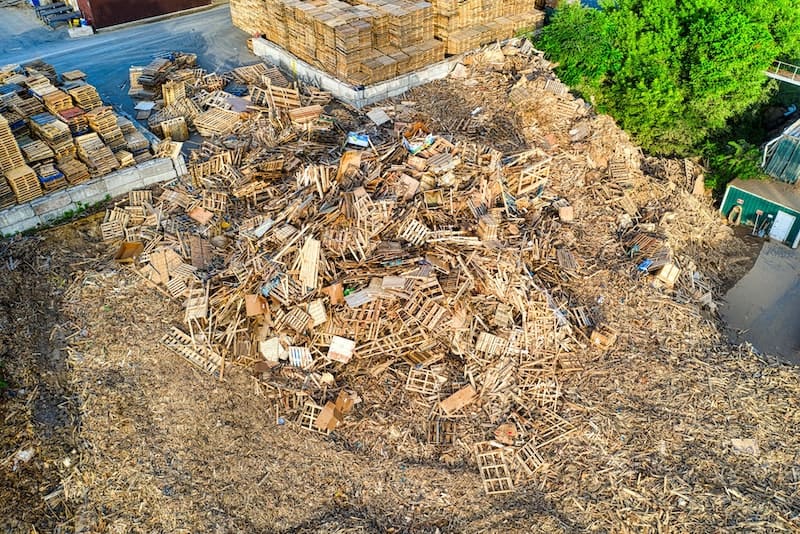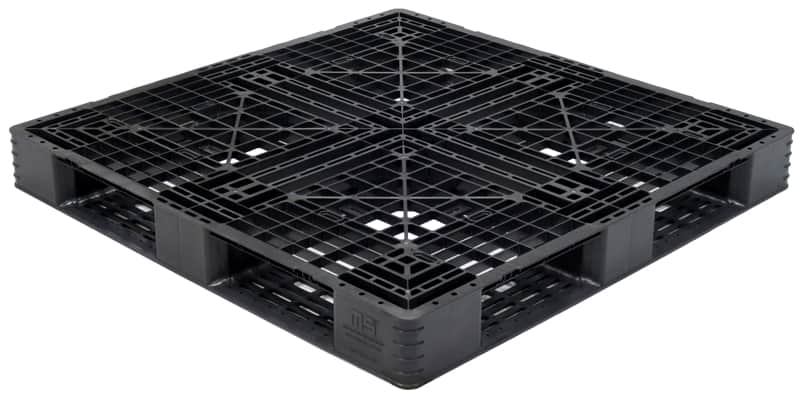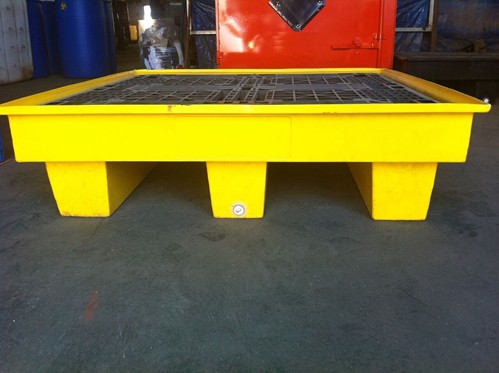

In the pharmaceutical industry, hygiene, sanitation and efficiency are all of the utmost importance throughout the entire shipping operations process. In regards to plastic vs wood pallets, all packaging and materials, shipping methods and routes must contribute efforts. It is done to ensure that each product produced and shipped meets hygiene requirements.
Plastic pallets outperform wood pallets by a large margin.
From a logistics and operations perspective, organisations must have a robust process in place to minimise the risk of contamination. As pallets are involved in a significant amount of shipping, the type of shipping pallet used is a key part of supply chain planning.
Plastic Pallets vs Wooden Pallets For Pharmaceutical Hygiene


Both types of pallets inherently meet requirements in that they enable the business involved to transfer a significant amount of goods from one location to another without individually transporting items.
However, while that may suffice in some industries, in the pharmaceutical world, it comes down to which pallets are easiest to continually keep clean and contamination-free.
Hygiene is of utmost importance for food and beverage and pharmaceuticals. And when it comes to hygiene, wooden pallets and plastic pallets have some key differences.
The Challenges Of Working With Wooden Pallets


Wooden pallets provide several challenges when it comes to sanitation. Cleaning wooden pallets with water can lead to moisture retention. This then leads to issues with mould and fungal growth.
Within the pharmaceutical industry, several well-known bodies had to recall a number of their products in 2010 and 2011 due to health concerns originating from their choice of wooden pallets. The companies received reports from customers of sickness and diarrhea as well as an unusual musty odour. The incident led to an investigation that found the breakdown of chemical, 2,4,6-tribromoanisole, used as a preservative and flame retardant may have been to blame, causing fungal growth in high moisture conditions.
“Wood pallets have been blamed for the recent product recall, but sources agree that more information is needed.” Read about these recalls in this Modern Materials Handling article titled, “Wood Pallets Cited As Cause For McNeil’s Tylenol Recall.”
Reportedly, at least one of the organisations involved with a similar potential wooden pallet contamination issue made the switch to plastic pallets.
Aside from concerns around mould and fungal growth, wooden pallets also present difficulties in terms of pest contamination. Pest-contaminated wooden pallets can easily spread and greatly affect the state of the product.


Wooden pallets can also more easily break. Splinters can go unnoticed and then go on to infect the shipment or injure handlers who in turn affect the legitimacy of the products.
Organisations using wooden pallets must ensure they have stringent health and safety procedures in place.
Plastic Vs Wood Pallets: 4 Efficiency Benefits
A few years ago, Swedish giant Ikea redesigned their Bang mug no fewer than three times, to reduce their shipping costs by 60 per cent, according to Fronetics. They felt the initial design was flawed because it could only fit 864 mugs on each pallet.
They added a rim to increase the number of mugs per pallet to 1,280. A subsequent modification changed the mugs to be shorter and modified the curve of the handle, increasing the number of mugs that could be stored on a pallet to 2,024. While the Bang mug price had not changed, the improvements in design resulted in a 60% reduction in shipping expenses.
From 864 on a pallet to 2,024 fittings on a pallet. Given that Ikea sells over 25 million Bang mugs per year. You can see how these design changes created significant savings for the company.
The Bang mug is just one example of how important a watertight logistics system is in reducing an organisation’s overall costs – especially optimising pallet space. How a company incorporates plastic pallets into their supply chain. It can determine transport costs, load and unload time, safety and the state in which a product reaches its end destination.
On the next look at plastic vs wooden pallets, here are 4 ways plastic pallets increase business efficiency.
1) Lightweight Pallets Are Available In Different Sizes
Lightweight plastic pallets come in a range of sizes which means there’s no need to ship a half-empty pallet. Having pallets or containers in a logistics system that fit the products being shipped can represent savings both in terms of warehouse storage and shipping. It may be possible to move to a smaller storage facility or optimise the way it is organised by moving to smaller pallets, and the size of a shipment can affect the transport rates applied when charged by space.
A range of sizes is available means that plastic pallets fit into other warehouse systems – such as pallet internal pallet transportation on forklifts and pallet jacks. Even minutes wasted on moving incoming or outgoing shipments add up to significant periods over a year. As a result, making different parts of the chain must fit together seamlessly.
Plastic pallets are also guaranteed to be the same size and weight every time, allowing systems to be designed around them if required.


2) Designs That Work With Other Systems
Pallets are specifically designed with storage and industry needs in mind. It also represents efficiency in terms of space management and health and safety.
Nestable pallets, which sit inside each other when stacked, are crucial for saving space. Therefore costs in closed-loop or return systems, both during transportation and storage. A truck that usually fits 500 pallets can transport 1,200 nestable pallets, according to Inbound Logistics – a significant difference.
In industries such as pharmaceuticals, spill containment bunded pallets are essential for health and safety. And it also plays a vital role in minimising associated cleanup or waste disposal costs.
3) Lightweight Pallets Are Hygienic and Easy-To-Clean


As previously discussed, cleaning plastic pallets is much easier than wood. This is crucial in industries such as pharmaceuticals and food and beverage. As well as the cleaning process is quick and easy, with no wear through repeated washing. Plastic pallets also can’t be contaminated as wooden ones can. Wooden pallets can harbour dust and mould, and present problems when used in high-moisture areas.
Issues such as infestation or weakening mean that wooden pallets represent continuous replacement costs. Effective cleaning of wooden pallets takes additional time and also incurs further expenses.
Plastic pallets are ready to go – there’s no need to have them fumigated and certified to meet ISPM 15 standards, unlike wooden ones. If plastic pallets are in a supply chain they can be used as intended, with no additional delays or costs associated.
4) Lightweight, Yet Stronger
Despite their lightweight, lightweight plastic pallets are very strong and consistent in strength. Unlike, the wooden variety which is made from inconsistent pieces of wood. With consistent strength, heavier goods can be shipped in larger numbers. Again it led to maximising the potential of each pallet by filling it.
Stronger pallets are also longer-lasting. Meaning ongoing repurchasing costs are minimal, assuming they are in a system whereby they are returned to the original owner. They’re also weather-resistant and can withstand fluctuating temperatures more easily than wooden pallets. This makes them ideal for a wide variety of products and locations.
Wooden pallets are often the cheapest type to buy in the first place and replace in due course, which is crucial for some organisations. In such cases where wood is opted for due to the initial plastic pallet price comparison. If you’re using wooden pallets you must ensure you have a stringent health and safety procedure in place. Learn more on cost comparisons of plastic pallets vs wooden pallets in our Why Plastic Pallets side-by-side cost breakdown.
With plastic pallets, initial purchasing costs can be higher than with wooden pallets. The same goes for ongoing replacement costs. However, when looking at plastic vs wood pallets, plastic pallets have a much longer shelf life than the wooden alternative, which generally only survive a handful of uses. As a result of this short shelf life on wooden pallets, they are often used just once without arrangements for a return.
Plastic Pallets Consistently Outperform Wooden Pallets
In terms of hygiene and cleanliness, plastic pallets show a clear advantage over their wooden counterparts.
Whether you are working with a smooth surface hygiene pallet or an open-deck design, cleaning plastic pallets is easy and can be done with water or other liquid-based disinfectants.
They can then be left to dry without the risk of mould growth.
Spills do not seep into plastic and can be easily wiped away. There is also no risk of pest or dust contamination. And, they do not easily break or splinter.
Pharmaceutical Plastic Pallets can be used for hundreds of shipments and last up to 10 years if properly cared for.
To talk about which pallets suit your business needs, and how we could help you reduce costs, increase efficiency, improve the hygiene in your shipping process and ensure your operation maintains high standards, contact the Eco Pallets team today!
Next Article: Pallet Export Requirements In Australia







